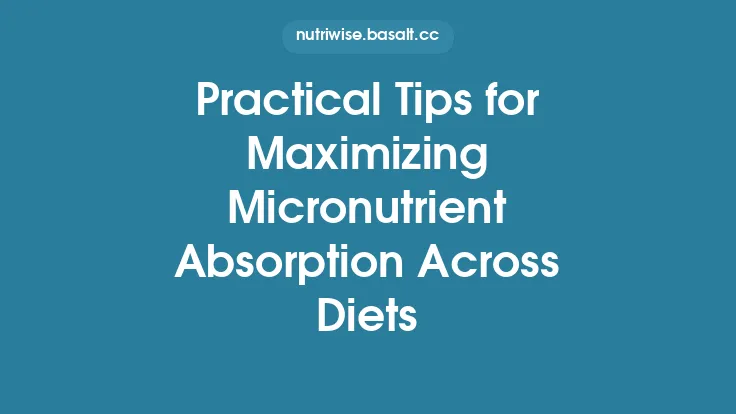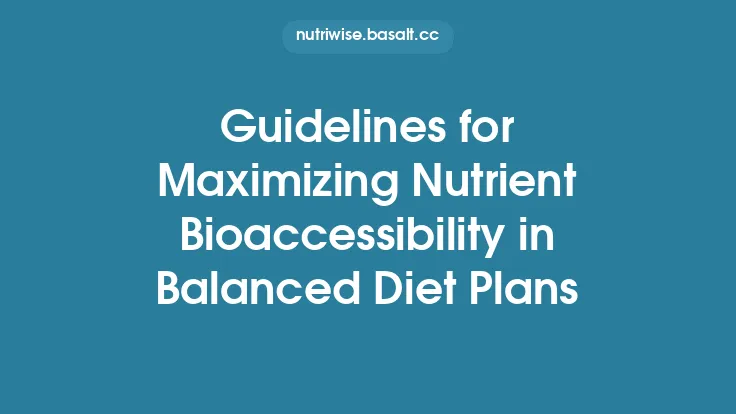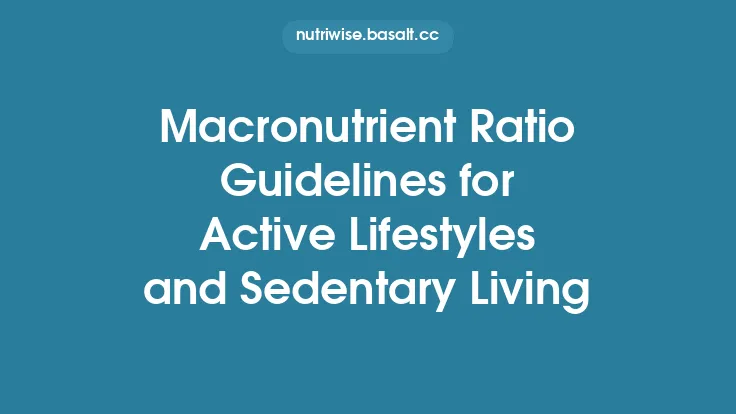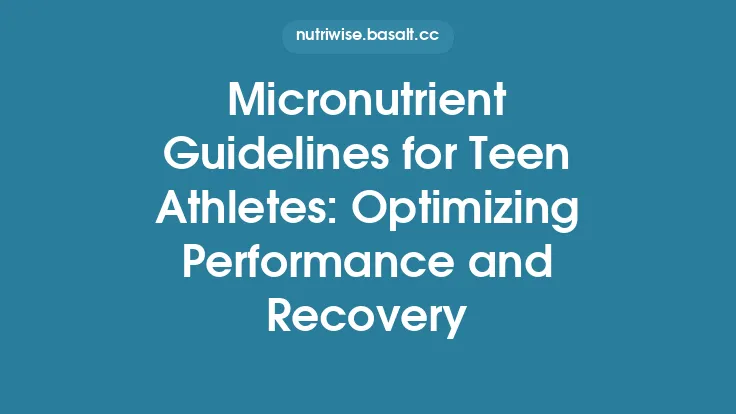Vitamin B12 (cobalamin) is an essential water‑soluble vitamin that serves as a cofactor for several critical enzymatic reactions, most notably the conversion of homocysteine to methionine and the synthesis of succinyl‑CoA in the mitochondrial tricarboxylic acid cycle. Deficiency can manifest as megaloblastic anemia, neurological disturbances, and, in severe cases, irreversible cognitive impairment. Because natural B12 sources are predominantly animal‑derived, vegetarians—especially vegans—must adopt deliberate strategies to ensure adequate intake and optimal absorption.
Understanding Vitamin B12 and Its Biological Role
Vitamin B12 exists in several interconvertible forms (cyanocobalamin, methylcobalamin, adenosylcobalamin, and hydroxocobalamin). While all are biologically active after conversion, the body’s absorption pathway treats them uniformly. The vitamin is stored primarily in the liver, with a typical adult reserve sufficient for 3–4 years, yet daily requirements remain around 2.4 µg for most adults. The physiological importance of B12 extends beyond hematopoiesis to myelin synthesis, DNA methylation, and energy metabolism, underscoring the need for reliable bioavailability.
Unique Challenges for Vegetarian Diets
- Absence of Natural Food Sources – Unprocessed plant foods contain negligible B12. Fermented products (e.g., tempeh, miso) and certain algae may contain B12 analogues (pseudocobalamins) that are not bioactive and can even compete with true B12 for absorption sites.
- Reliance on Fortified Foods and Supplements – The primary vegetarian sources are foods fortified with synthetic B12 and oral supplements. The bioavailability of fortified B12 depends on the matrix in which it is embedded and the form used.
- Potential for Subclinical Deficiency – Even with adequate intake, absorption can be compromised by factors such as reduced gastric acidity, certain medications (e.g., proton‑pump inhibitors), and age‑related decline in intrinsic factor production.
Mechanisms of Vitamin B12 Absorption
The absorption cascade involves several distinct steps:
- Release from Food Matrix – In the stomach, pepsin and gastric acid liberate B12 from protein complexes. For fortified foods, the vitamin is already free or loosely bound, facilitating release.
- Binding to Haptocorrin (R‑binding protein) – Once free, B12 initially binds to haptocorrin secreted by salivary glands and gastric mucosa, protecting it from acidic degradation.
- Transfer to Intrinsic Factor (IF) – In the duodenum, pancreatic enzymes degrade haptocorrin, allowing B12 to bind intrinsic factor, a glycoprotein essential for receptor‑mediated uptake.
- Receptor‑Mediated Endocytosis – The B12‑IF complex travels to the terminal ileum, where it binds the cubilin‑amnionless receptor complex and is internalized.
- Transport in the Bloodstream – After absorption, B12 dissociates from IF and binds transcobalamin II for delivery to peripheral tissues.
Only a small fraction (≈1–2 %) of dietary B12 is absorbed via the IF‑dependent pathway. However, the intestine also possesses a passive diffusion route that can absorb up to 1 % of a large oral dose, independent of IF. This passive route becomes clinically relevant when high‑dose supplements are used.
Dietary Strategies to Enhance Absorption
| Strategy | Rationale | Practical Implementation |
|---|---|---|
| Choose Fortified Foods with Cyanocobalamin | Cyanocobalamin is the most stable synthetic form and is efficiently released from fortified matrices. | Incorporate fortified plant milks, breakfast cereals, nutritional yeast, and meat analogues that list cyanocobalamin on the label. |
| Consume B12‑Rich Foods with Acidic Beverages | Mild acidity can aid the release of B12 from fortified matrices, mimicking gastric conditions. | Pair fortified cereal with orange juice or a splash of lemon juice. |
| Space Out B12 Intake Throughout the Day | The IF‑dependent pathway saturates quickly; spreading doses maximizes IF‑mediated uptake. | Aim for 2–3 servings of fortified foods or split supplement doses (e.g., 250 µg in the morning, 250 µg at lunch). |
| Avoid High Doses of Vitamin C Simultaneously | Very high concentrations of ascorbic acid can degrade free B12 in the gut lumen. | Keep vitamin C intake separate (e.g., consume citrus fruit at a different time than fortified B12 foods). |
| Maintain Adequate Pancreatic Function | Pancreatic proteases are required to degrade haptocorrin, freeing B12 for IF binding. | Ensure sufficient dietary fat and protein to stimulate pancreatic secretion; consider a balanced macronutrient profile. |
| Limit Alcohol Overconsumption | Chronic heavy alcohol intake impairs gastric mucosal integrity and IF production. | Moderate alcohol intake (≤1 drink/day for women, ≤2 drinks/day for men). |
Optimizing Supplement Use
- Form Selection – Cyanocobalamin and methylcobalamin are both effective; cyanocobalamin offers superior stability, while methylcobalamin may be preferred for individuals seeking a “natural” form. Hydroxocobalamin, often used in injectable preparations, has a longer plasma half‑life and can be advantageous for maintenance dosing.
- Dosage Considerations – For individuals with normal IF function, a daily dose of 25–100 µg from fortified foods typically suffices. In cases of reduced IF activity (e.g., older adults, long‑term PPI users), a higher oral dose (≥500 µg) leverages the passive diffusion route.
- Timing Relative to Meals – Taking supplements on an empty stomach (30 minutes before or 2 hours after a meal) can reduce competition for gastric binding sites and improve IF interaction.
- Formulation Type – Sublingual tablets and lozenges bypass the gastric environment, delivering B12 directly to the oral mucosa where it can be absorbed into the systemic circulation. Evidence suggests comparable bioavailability to oral tablets for doses up to 500 µg.
- Monitoring for Over‑Supplementation – Although B12 toxicity is rare, extremely high serum levels may mask underlying absorption defects. Periodic testing (serum B12, methylmalonic acid, homocysteine) is advisable for high‑dose users.
Practical Meal‑Planning Tips
- Breakfast: Fortified oat milk (250 µg B12) + whole‑grain toast + a squeeze of lemon juice.
- Mid‑Morning Snack: Nutritional yeast‑sprinkled popcorn (2 µg B12).
- Lunch: Mixed greens with tofu, fortified soy sauce, and a side of fortified rice (5 µg B12).
- Afternoon: Orange juice (vitamin C source) separate from B12‑rich foods.
- Dinner: Plant‑based burger patty with fortified bun, accompanied by a small serving of fortified plant‑based cheese (10 µg B12).
- Evening: If needed, a sublingual cyanocobalamin tablet (250 µg) taken 30 minutes before bedtime.
By distributing B12 sources across meals and ensuring at least a modest acidic environment with each intake, vegetarians can maximize IF‑mediated absorption while also capitalizing on passive diffusion for any excess.
Monitoring Status and Adjusting Intake
Regular assessment is essential because B12 status can change silently. Recommended biomarkers include:
- Serum Vitamin B12 – Primary screening; values <200 pg/mL suggest deficiency, 200–300 pg/mL is borderline.
- Methylmalonic Acid (MMA) – Elevated MMA is a sensitive indicator of functional B12 deficiency, even when serum B12 appears normal.
- Homocysteine – Elevated levels reflect impaired B12‑dependent remethylation pathways.
- Complete Blood Count (CBC) – Look for macrocytic anemia (MCV >100 fL) as a downstream effect.
If any marker indicates insufficiency, increase fortified food intake by 25–50 % or introduce a supplemental regimen (e.g., 500 µg cyanocobalamin daily). For persistent low levels despite adequate intake, evaluate for malabsorption (e.g., pernicious anemia) and consider intramuscular B12 administration under medical supervision.
Emerging Research and Future Directions
- Nanoparticle‑Encapsulated B12 – Preliminary studies suggest that encapsulating B12 in lipid‑based nanoparticles can protect it from gastric degradation and enhance ileal uptake, potentially reducing required doses.
- Genetic Polymorphisms in Cubilin – Variants affecting the cubilin receptor may influence individual absorption efficiency; personalized nutrition approaches could tailor B12 recommendations based on genotype.
- Microbial Production of Bioactive B12 – Certain probiotic strains are being engineered to synthesize active B12 in situ, offering a novel avenue for vegetarians, though clinical efficacy remains under investigation.
Continued investigation into these areas promises to refine guidelines and expand options for vegetarians seeking reliable B12 nutrition.
Summary of Key Guidelines
- Prioritize fortified foods that list cyanocobalamin; aim for at least 25 µg daily from multiple sources.
- Distribute intake across meals to avoid saturating the IF pathway.
- Pair B12 sources with mild acidity (e.g., citrus juice) but keep high‑dose vitamin C separate.
- Select appropriate supplements: cyanocobalamin for stability, methylcobalamin for those preferring a methylated form; consider higher doses if IF function is compromised.
- Monitor biomarkers (serum B12, MMA, homocysteine) at least annually, or more frequently if risk factors exist.
- Adjust intake promptly based on laboratory feedback, and seek medical evaluation for persistent low levels.
By integrating these evidence‑based practices into daily dietary patterns, vegetarians can confidently maintain optimal vitamin B12 status, supporting hematologic health, neurological function, and overall metabolic vitality.





